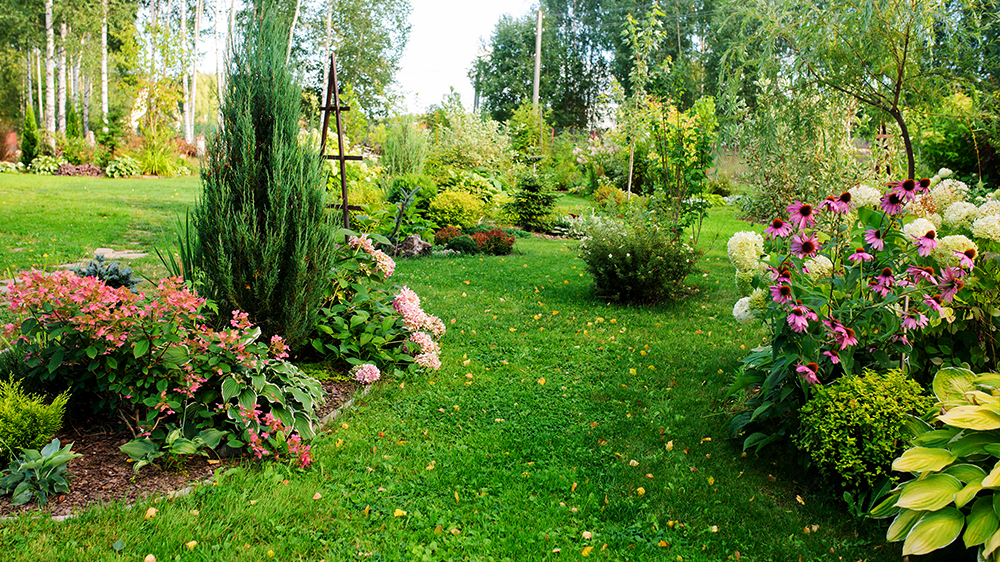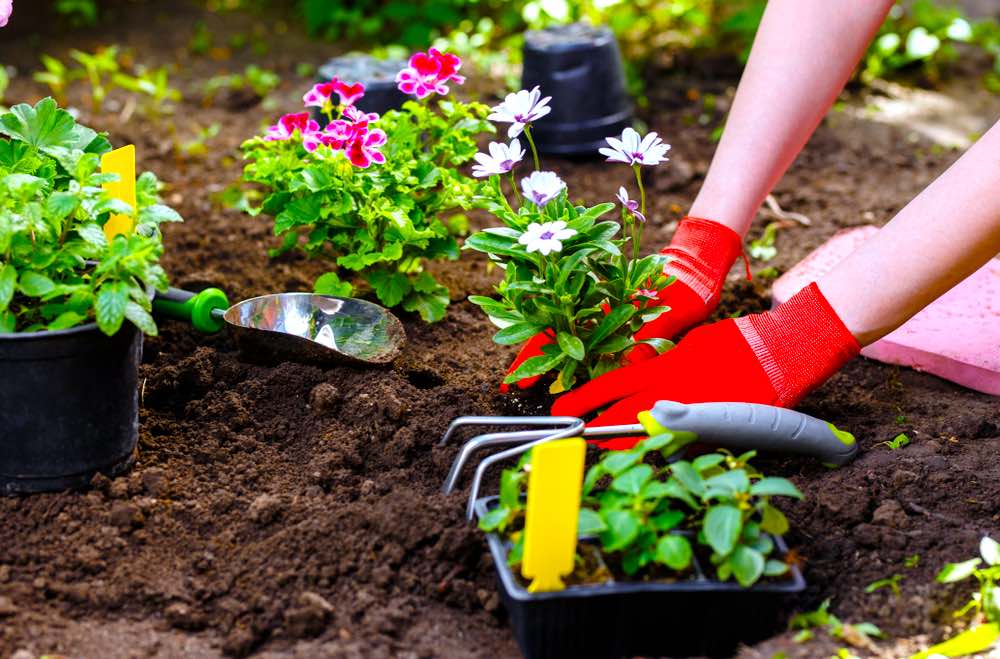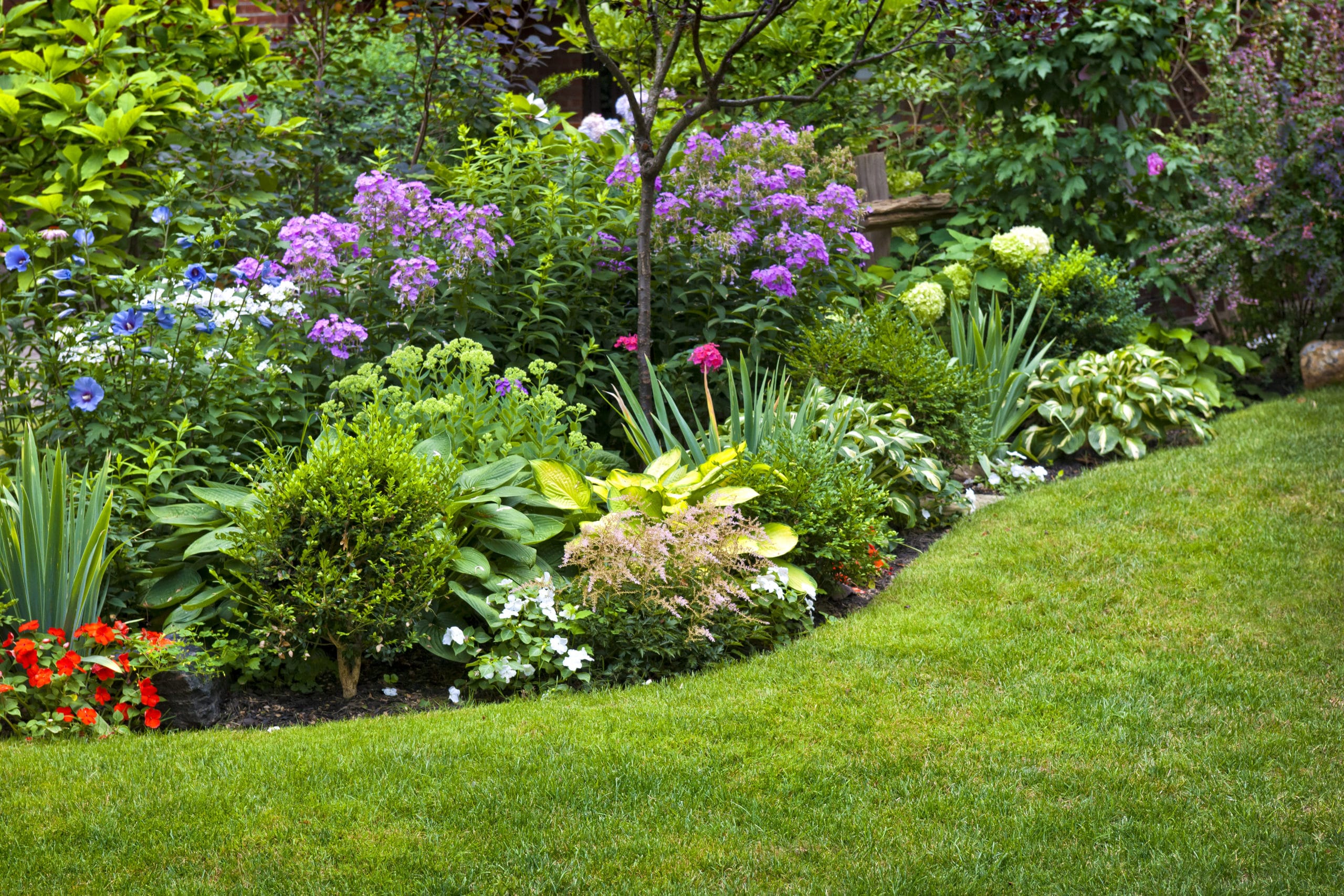The Allure of Low-Maintenance Gardening
Imagine a vibrant and colorful flower garden that bursts with life, but requires minimal effort from you. This is the dream of many, especially beginners who are intimidated by the demands of traditional gardening. Low-maintenance flower gardens offer a fantastic way to enjoy the beauty of nature without sacrificing your valuable time or energy.
The appeal of low-maintenance gardening lies in its simplicity and practicality. It's about creating a thriving garden that requires minimal upkeep, allowing you to focus on enjoying its beauty rather than tending to it constantly. This approach emphasizes choosing the right plants, incorporating smart design techniques, and using sustainable practices to create a self-sustaining ecosystem.
Key Elements of Low-Maintenance Gardening

A low-maintenance garden is built upon a foundation of carefully chosen elements that work together to create a self-sufficient ecosystem.
Here are some key elements:
- Selecting Low-Maintenance Plants: Choosing plants that are naturally drought-tolerant, disease-resistant, and require minimal pruning is crucial. Examples of such plants include:
- Perennials: These plants return year after year, requiring minimal maintenance. Examples include coneflowers, lavender, and yarrow.
- Native Plants: Plants native to your region are well-adapted to the local climate and soil conditions, requiring less water and care. Examples include black-eyed Susans, butterfly weed, and mountain mint.
- Succulents: These water-storing plants thrive in dry conditions and require minimal watering. Examples include sedum, echeveria, and aloe.
- Strategic Planting Design: Planning your garden layout to maximize space and minimize maintenance is essential.
- Companion Planting: Planting compatible species together can create a mutually beneficial ecosystem. For example, planting marigolds near tomatoes can repel pests and attract beneficial insects.
- Mulching: Applying a layer of mulch around your plants helps retain moisture, suppress weeds, and regulate soil temperature. Organic mulches like wood chips or shredded bark decompose over time, enriching the soil.
- Water Wisely: Water conservation is a key element of low-maintenance gardening.
- Drip Irrigation: This system delivers water directly to the roots of plants, minimizing evaporation and waste. This is a highly efficient way to water your garden, particularly in dry climates.
- Rainwater Harvesting: Collecting rainwater from rooftops and using it to water your garden can significantly reduce your water usage.
Soil Preparation
Imagine a beautiful garden, bursting with vibrant blooms and lush foliage. It all starts with a solid foundation – the soil. Soil preparation is the key to a thriving low-maintenance garden, ensuring your plants have the ideal environment to flourish.
Soil Testing
Soil testing is like getting a health check-up for your garden. It helps you understand the existing soil conditions, identifying any imbalances that might hinder plant growth.
- A soil test reveals the pH level, which measures acidity or alkalinity. Most plants prefer a slightly acidic pH range (6.0-7.0).
- It also identifies the levels of essential nutrients like nitrogen, phosphorus, and potassium, crucial for plant growth and development.
- You can purchase soil testing kits online or at gardening centers. Alternatively, your local extension service often offers free soil testing services.
Soil Amendments
Based on the soil test results, you can amend your soil to create the perfect environment for your plants. This involves adding materials to improve its structure, drainage, and nutrient content.
- If your soil is too acidic, you can add lime to raise the pH level.
- For alkaline soil, you can use sulfur to lower the pH.
- Adding organic matter, such as compost, aged manure, or leaf mold, improves soil structure, aeration, and water retention.
- For sandy soil, adding clay or peat moss can improve water retention.
- Clay soil benefits from the addition of sand or compost to improve drainage.
Tilling the Soil
Tilling is the process of loosening and turning the soil, preparing it for planting. It breaks up compacted soil, aerates it, and incorporates amendments.
- For smaller gardens, you can use a hand tiller or garden fork.
- Larger gardens may require a power tiller or rototiller.
- Avoid tilling too deeply, as it can disrupt beneficial microorganisms and soil structure.
Planting Strategies

A well-planned planting strategy is crucial for a thriving low-maintenance flower garden. This ensures your garden blooms continuously, attracts pollinators, and requires minimal effort from you.
Companion Planting
Companion planting involves strategically placing different plant species together to enhance their growth and health. This technique can deter pests, attract beneficial insects, and improve soil fertility.
- Marigolds and Tomatoes: Marigolds repel nematodes, tiny worms that can damage tomato roots, while attracting beneficial insects like ladybugs that feed on aphids.
- Basil and Tomatoes: Basil repels whiteflies and other pests that can harm tomatoes, while its aroma improves the flavor of tomatoes.
- Lavender and Roses: Lavender repels aphids and other pests that attack roses, while attracting beneficial insects that pollinate roses.
Staggered Planting, Creating a low-maintenance flower garden for beginners
Staggered planting involves planting different varieties of flowers with varying bloom times throughout the season. This technique ensures continuous blooms in your garden, extending the enjoyment of flowers from spring to fall.
- Early Bloomers: Plant early bloomers like pansies, tulips, and daffodils for a burst of color in spring.
- Mid-Season Bloomers: Plant mid-season bloomers like zinnias, sunflowers, and cosmos for vibrant colors in summer.
- Late Bloomers: Plant late bloomers like asters, chrysanthemums, and sedums for fall color and interest.
Fertilizing

While low-maintenance gardening prioritizes minimal intervention, it doesn't mean neglecting your plants' nutritional needs. Fertilizing plays a crucial role in ensuring your flowers thrive and produce vibrant blooms. The right approach involves providing the necessary nutrients without overwhelming the soil and potentially causing harm.
Natural Fertilizers and Organic Amendments
Choosing natural fertilizers and organic amendments is a cornerstone of low-maintenance gardening. These options promote healthy soil structure, improve water retention, and release nutrients gradually, reducing the need for frequent applications.
- Compost: This gold standard of organic matter is a treasure trove of nutrients and beneficial microorganisms. It improves soil structure, enhances drainage, and provides a slow-release source of nutrients for your plants.
- Manure: A readily available and effective fertilizer, manure adds nutrients and improves soil texture. However, ensure it's properly composted to avoid introducing weed seeds or pathogens.
- Fish Emulsion: This liquid fertilizer derived from fish byproducts is rich in nitrogen, phosphorus, and potassium, promoting lush foliage and vibrant blooms.
- Seaweed Extract: A natural source of growth hormones and micronutrients, seaweed extract helps plants overcome stress and enhances their overall health.
- Bone Meal: This slow-release phosphorus source is particularly beneficial for root development and flower production.
- Blood Meal: A high-nitrogen fertilizer, blood meal provides a quick boost to plant growth, especially for leafy greens and flowering plants.
Remember to apply fertilizers according to the specific needs of your plants and the instructions on the product label. Over-fertilizing can lead to nutrient imbalances and damage to your plants.
Pest and Disease Management

Even low-maintenance gardens can fall victim to pests and diseases, but with proactive measures, you can keep your garden healthy and thriving.
Identifying Common Pests and Diseases
Low-maintenance gardens, with their focus on native plants and natural processes, are often less susceptible to serious pest and disease outbreaks than intensively managed gardens. However, it's still important to be aware of potential threats.
- Insects: Aphids, whiteflies, spider mites, and leafhoppers are common garden pests. These insects can suck sap from plants, causing wilting and discoloration.
- Diseases: Fungal diseases like powdery mildew, rust, and black spot can affect the leaves and stems of plants, leading to stunted growth and reduced flowering.
- Rodents: Mice and voles can damage roots and stems, especially in winter when other food sources are scarce.
- Birds: While birds are generally beneficial to gardens, some species, like finches, can damage flower buds and seeds.
Natural Pest and Disease Control
Creating a low-maintenance flower garden for beginners - A healthy garden is the best defense against pests and diseases. By promoting a balanced ecosystem, you can encourage beneficial insects and other organisms that help control pest populations.
- Encourage beneficial insects: Planting a variety of flowering plants, including those that attract ladybugs, lacewings, and parasitic wasps, can help control pest populations.
- Use companion planting: Certain plant combinations can deter pests or attract beneficial insects. For example, planting marigolds near tomatoes can repel whiteflies.
- Hand-pick pests: For small infestations, hand-picking pests can be an effective control method.
- Use organic sprays: Neem oil, insecticidal soap, and horticultural oil are safe and effective alternatives to chemical pesticides.
- Maintain good garden hygiene: Removing diseased or damaged plant material and keeping weeds under control can help prevent the spread of pests and diseases.
Disease Prevention
Preventing diseases is often more effective than treating them. By taking these steps, you can minimize the risk of fungal and bacterial infections.
- Choose disease-resistant varieties: When selecting plants for your garden, choose varieties known for their resistance to common diseases.
- Provide good air circulation: Ensure that plants have adequate space for air to circulate, reducing the risk of fungal diseases that thrive in humid environments.
- Water deeply but infrequently: Overwatering can create conditions favorable for fungal growth.
- Avoid overhead watering: Water at the base of plants to prevent the spread of fungal spores.
Winterizing Your Garden
While your low-maintenance garden thrives on simplicity, a little preparation during the off-season can make a significant difference in its health and beauty come spring. Winterizing your garden is not just about tidying up; it's about protecting your plants from harsh weather and setting them up for a successful growing season ahead.
Preparing the Garden for Winter
Winterizing your low-maintenance garden involves a few key steps to ensure its survival and set the stage for a flourishing spring. These steps protect your plants, prevent pests and diseases, and ensure a clean and healthy environment for the next growing season.
- Clear the Debris: Fallen leaves, dead stems, and other garden debris can harbor pests and diseases. Remove them from the garden and dispose of them properly. This prevents overwintering pests and reduces the risk of fungal infections.
- Prune Back Plants: Many plants benefit from a winter pruning. This removes dead or diseased branches, encourages healthy growth, and improves air circulation. Prune back perennials to about 6 inches above the ground, and cut back any woody stems or branches that have died back.
- Protect Vulnerable Plants: Some plants, such as roses and certain perennials, may need additional protection during the winter months. Mulch around the base of these plants with a layer of organic material like straw, wood chips, or shredded leaves. This helps insulate the roots and protect them from frost.
- Clean Garden Tools: Before storing your garden tools for the winter, clean them thoroughly to prevent the spread of diseases and pests. Wipe them down with a disinfectant solution and allow them to dry completely before storing them in a dry, sheltered place.
Creating a Beautiful and Sustainable Garden: Creating A Low-maintenance Flower Garden For Beginners
A low-maintenance garden doesn't have to be boring! With a little creativity, you can create a space that's both beautiful and easy to care for. Here are some additional tips for adding visual interest and making your garden more sustainable.
Adding Visual Interest
Adding visual interest to your garden doesn't have to be complicated or time-consuming. Here are a few simple ideas:
- Vertical Gardening: Transform a blank wall or fence into a vibrant green space by creating a vertical garden. You can use a variety of methods, such as hanging planters, wall-mounted trellises, or even repurposed pallets. Vertical gardening is perfect for small spaces and can add a unique dimension to your garden. Imagine a wall covered in cascading vines or a colorful display of flowering plants, all growing upwards!
- Container Planting: Container gardening offers endless possibilities for creating eye-catching displays. Use different sizes and shapes of pots, from terracotta to metal, to create a dynamic arrangement. You can group plants together based on color, texture, or height, or create a focal point with a single stunning specimen. The beauty of container gardening is that you can easily move plants around to change the look of your garden throughout the seasons.
- Using Different Textures: Mixing different textures can add depth and interest to your garden. Choose plants with contrasting leaf shapes and sizes, such as feathery ferns alongside broad-leaved hostas. You can also incorporate elements like gravel, stone, or wood to create visual contrast and add a touch of rustic charm.
Sustainable Practices
Sustainable gardening is about creating a healthy and thriving ecosystem while minimizing your environmental impact. Here are some ways to incorporate sustainable practices into your low-maintenance garden:
- Using Recycled Materials: Give new life to old materials by incorporating them into your garden design. Use recycled bricks or stones to create pathways, build raised beds, or create unique garden art. Old tires can be transformed into planters, and wooden pallets can be used to create vertical gardens or seating areas.
- Attracting Beneficial Insects: Instead of using harsh chemicals to control pests, create a habitat that attracts beneficial insects like ladybugs, lacewings, and parasitic wasps. These insects naturally prey on garden pests, helping to keep your plants healthy without the need for pesticides. You can attract these beneficial insects by planting flowering plants that provide nectar and pollen, and by providing shelter in the form of logs, rocks, or leaf litter.
- Composting: Composting is a great way to reduce waste and create nutrient-rich soil amendments. Compost can be made from kitchen scraps, yard waste, and even shredded paper. By adding compost to your garden beds, you're enriching the soil with essential nutrients, improving drainage, and promoting healthy plant growth. It's a win-win for your garden and the environment!
Essential Questionnaire
What are some of the best low-maintenance flowers for beginners?
Some excellent choices include zinnias, cosmos, sunflowers, marigolds, and lavender. These flowers are known for their resilience, drought tolerance, and ability to attract pollinators.
How often should I water my low-maintenance flower garden?
It depends on the climate and the type of flowers you've planted. A good rule of thumb is to water deeply but less frequently, allowing the soil to dry out slightly between waterings.
Can I use organic fertilizers for my low-maintenance garden?
Absolutely! Organic fertilizers, such as compost, manure, and fish emulsion, are great options for nourishing your flowers without harsh chemicals.
